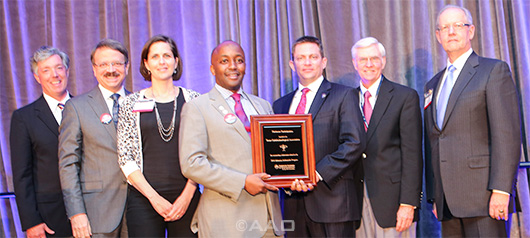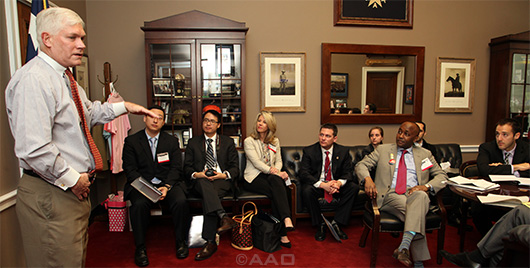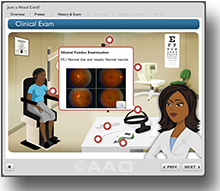What's Happening
2014 Mid-Year Forum
In early April, more than 450 ophthalmologists gathered in Washington, D.C., to discuss some of ophthalmology’s most critical issues with regulators, legislators, and Academy leaders. EyeNet summarizes three Mid-Year Forum (MYF) sessions below.
From Volume to Value: Finding Balance in a Changing Reimbursement Landscape. Evolving laws and regulations for value-based (as opposed to volume-based) payment models will impact how physicians and facilities are reimbursed for their services. This session focused on the latest news regarding Medicare and private plan alternative payment models and examined the factors driving changes in the marketplace—with a focus on the repercussions for ophthalmology.
Cloning, Coding, Compliance: Managing the New Risks of EHRs. Ophthalmologists need to devote resources to achieving meaningful use in order to qualify for incentive payments and avoid penalties, but many practices will not be ready. Experts have identified a number of issues that pose risks for physicians acquiring this technology in terms of professional liability, compliance with meaningful use, HIPAA, data security, and other regulatory requirements.
There have been a number of reports about the medicolegal risks associated with data cloning by physician care providers do not devote appropripractices and about the risks to patient ate attention to data security. In this privacy and data integrity when health hearing, a panel of experts helped ophthalmologists address gaps in knowledge and experience across the range of issues.
Crunching Your Numbers: Big Data Beyond the Registry. An information technology revolution is under way. It’s called “big data,” and it has already transformed multiple industries. In health care, big data promises to change everything from health care coordination to reimbursement.
To successfully analyze big data, organizations need to think beyond the sheer volume of information to its varied types. In some cases, that means asking new questions about the kinds of information that sources such as EHRs, medical imaging data sets, epidemiological studies, and clinical data registries can provide. This session examined how the U.S. health care system can effectively obtain and use big data to provide—and quantify—excellent care to improve outcomes; ensure that all of a patient’s providers have access to the same information; and deliver effective, efficient, evidence-based care for more patients.
To view the MYF Report, check out the Academy's MYF Web page.
 |
|
ADVOCACY AMBASSADORS AT THE MID-YEAR FORUM. On April 11 in Washington, D.C., the Academy awarded the 2014 Platinum Participation Award to leaders of the Texas Ophthalmological Association (TOA) for their outstanding contributions to the Academy’s Advocacy Ambassador Program, which educates residents and fellows about political action at the state and national levels. From left to right: Daniel J. Briceland, MD, Academy Secretary for State Affairs; Gregory L. Skuta, MD, Academy President; Rachael Reed, TOA Executive Director; Sidney K. Gicheru, MD, TOA President-Elect; Aaron M. Miller, MD, TOA Councilor; John R. Fish, MD, TOA Councilor; and David W. Parke II, MD, Academy Executive Vice President/CEO.
|
 |
|
2014 CONGRESSIONAL ADVOCACY DAY. A strong advocate and consistent supporter of Academy initiatives, Rep. Pete Sessions (R-Texas, far left) welcomes the Texas contingent from Congressional Advocacy Day, including several residents and fellows attending via the Academy’s Advocacy Ambassador Program. Also pictured from left to right: Alexander S. Davis, MD, David Truong, MD, Jane C. Edmond, MD, Aaron M. Miller, MD, Kinley D. Beck, MD, Sidney K. Gicheru, MD, Sohrab Tofigh, MD, and Robert B. Garoon, MD.
|
Take Notice
Hiring? Post Your Job at the Ophthalmology Job Center
The Academy’s Ophthalmology Job Center puts practices in touch with the most qualified and talented ophthalmologists and ophthalmic professionals in the United States. The website saves your practice time with its targeted hiring process, is cost-effective compared with paying a recruitment agency, and offers enhanced posting options to heighten visibility of your ad. The job center is viewed easily on desktops, tablets, and smartphones.
For more information and rates, visit the Ophthalmology Job Center.
Renew Your Academy Membership for 2014
Last October, you were sent your membership renewal packet in the mail. If you have not paid your Academy dues, this will be your last issue of EyeNet until payment is received. You can pay online, by phone at 866-561-8558 (toll-free in the United States) or 415-561-8581, or by fax at 415-561-8575.
Hardship-Exemption Option for EHR Incentive Program
CMS updated its guidance for physicians whose EHR vendors have not gained 2014 certification. Physicians can now apply for a hardship exemption from the Medicare EHR Incentive Program. Applications must be submitted by July 1.
All other providers are eligible for the incentive only if they use 2014-certified EHR software and successfully demonstrate the relevant stage(s) of the program’s meaningful use requirements. Providers who do not meet the requirements will receive a penalty on their 2015 Medicare claims.
For incentive program resources, visit the AAOE's Meaningful Use Web page.
Ask the Ethicist: When Residents Encounter Surgical Complications
Q: A clinic patient in our large tertiary care center was scheduled for routine outpatient, elective cataract surgery. The attending physician informed the patient that a resident would be involved in part of the surgery, and the patient signed an informed consent. During the surgery, a crack developed in the IOL implant. The problem was immediately recognized by the attending and the resident, but following surgery, it was not disclosed to the patient. Postoperatively, the patient had no symptoms from the cracked IOL and had a good outcome. Should someone have disclosed the error to the patient? If so, when?
A: Ideally, the cracked lens would have been discarded when discovered and not implanted in the first place. Either a new one would be used, or if unavailable, the patient would have been informed and offered the opportunity to reschedule the surgery. That said, once the complication occurred, the patient should have been informed of the problem as soon as possible after her procedure for several reasons:
- Principle 7 of the Code of Ethics states that “it is the responsibility of an ophthalmologist to act in the best interest of the patient”—and this includes honesty.
- Being truthful about an error engenders patient trust.
- Being truthful protects the integrity of the profession.
- Being truthful can minimize potential legal liability for the institution and the individual.
Admitting liability (i.e., stating that you’re legally or financially responsible for the outcome) could result in the denial of coverage for a resulting claim. You may wish to contact your carrier before talking with the patient. Currently, 36 states have some form of apology laws, which are intended to reduce medical liability/malpractice litigation.1 In general, they provide that a health care provider’s expression of apology, sympathy, commiseration, condolence, or compassion is inadmissible as evidence in a medicolegal proceeding and does not constitute an admission of liability or wrongdoing. Each state’s laws are different so be sure to check the details applicable to your practice.
___________________________
1 voicesinbioethics.org/2014/03/26/apology-laws-and-the-doctor-patient-relationship.
___________________________
To submit a question, e-mail ethics@aao.org.

ONE SPOTLIGHT: Test your clinical decision making. Visit the ONE Network for virtual case simulations based on real-life scenarios. Each case covers every step of a clinical encounter, from assessment through treatment.
Review the patient’s history and symptoms, conduct an exam, choose diagnostic tests, and find out if your diagnosis and treatment strategy are appropriate. Recent cases include:
- “Diplopia Following Cataract Surgery” A 68-year-old patient who underwent cataract surgery in his left eye returns one week later with complaints of double vision.
- “Just a Head Cold?” A 58-year-old woman presents with sinus pressure, postnasal drip, and painful irritation of the right eye that worsened over six weeks.
To view these cases and others, visit the ONE Network. |
Academy Store
BCSC: Updates on Pediatric Ophthalmology, Refractive Surgery, and Fundamentals
Keep your clinical knowledge current with the Academy’s 13-volume Basic and Clinical Science Course (BCSC). A comprehensive reference for research and clinical experience, it is used by ophthalmologists and residents worldwide. The 2014-2015 edition includes the following major revisions:
- Section 2: Fundamentals and Principles of Ophthalmology (print #02800024, e-book #02800024V).
- Section 6: Pediatric Ophthalmology and Strabismus (print #02800064, e-book #02800064V). Purchase also includes access to 12 videos covering diagnostic evaluation, procedures for vertical deviations, and surgery of the extraocular muscles.
- Section 13: Refractive Surgery (print #02800134, e-book #02800134V).
Save when you buy the print and e-book of a section together or when you purchase the 13-section set. Read e-books online from any browser or download to an iPad or Android tablet.
For more information and pricing, visit the Academy store.
Members at Large
ICO’s New Leadership
On April 7, Hugh R. Taylor, AC, MD, succeeded Bruce E. Spivey, MD, MS, MEd, as President of the International Council of Ophthalmology (ICO). Dr. Taylor said, “Dr. Spivey’s leadership as ICO President has served as an excellent example, and I will continue to steer the ICO in the same direction: broadening and improving ophthalmic education and access to quality eye care around the globe.”
D.C. Report
Advances in the Legislative Agenda
Grassroots advocacy is critical to advancing ophthalmology’s agenda, and the Academy frequently encourages the membership at large to contact lawmakers regarding their positions on specific issues. In fact, more than 3,600 Academy members sent more than 12,700 letters to members of Congress in 2013 alone by using the Academy’s advocacy website.
To further strengthen these efforts, the Academy’s Congressional Advocacy Program is developing a nationwide network of “grasstop” advocates. These are Academy members who volunteer to establish relationships with federal lawmakers and who are willing to work very quickly when called upon. These members communicate the Academy’s pro-ophthalmology, pro-patient priorities directly to their lawmakers. Congressional Advocates utilize their relationships with lawmakers to make personal appeals to advance the Academy’s legislative goals.
Two Congressional Advocates. Shortly after an in-district meeting with Rep. Dave Camp (R-Mich.), Academy Congressional Advocate James L. Jackson, MD, said, “Our representatives cannot consider our positions on the issues unless we make the effort to communicate with them. My Congressman tells me he wants to hear my opinions.” Rep. Camp is chairman of the powerful House Committee on Ways and Means, which has oversight of the Medicare program. Dr. Jackson’s strong relationship with Rep. Camp plays a key role in the Academy’s advocacy efforts on Medicare physician pay reform.
Another Congressional Advocate, Howard B. Goldman, MD, has developed relationships with members of Congress by inviting them to tour his surgical center. He used these opportunities to provide an ophthalmic perspective on federal health care legislation, including a bill that would make Academy-supported changes to the Medicare Electronic Health Record Incentive Program.
Consider becoming a Congressional Advocate. Through their relationships with lawmakers, Congressional Advocates become trusted sources on how certain bills and policies would impact their patients and practices. The Academy’s goal is to have at least one advocate in every congressional district. Most of the Academy’s Congressional Advocates have an existing relationship with their lawmaker, but those who do not have an established relationship are encouraged to develop one. The Academy has matched a Congressional Advocate to almost every member of Congress, but the goal is not complete.
To learn more about becoming a Congressional Advocate, visit the Academy's OphthPAC Web page or contact Sage Bauer at sbauer@aaodc.org or 202-737-6662.